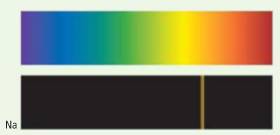
Concept explainers
Interpretation:
The two given spectrums need to be differentiated.

Concept introduction:
Atomic emission spectroscopy is the study of
Answer to Problem 117A
The first spectrum showing all the color is the complete visible spectrum and on the other hand, the second spectrum is showing certain colors which are emitted by sodium atoms is the atomic emission spectrum of sodium.
Explanation of Solution
Visible spectrum is a section of an electromagnetic spectrum, which is visible to the human eye. It includes a range of different colors representing particular wavelength. Electromagnetic radiation in this range of wavelengths is termed as visible light. The atomic spectra correlate the range of light frequencies emitted or absorbed by the element that happens when the electrons move between the allowed energy levels for that specific atom. Therefore, when an electron moves from a higher energy level to the lower energy level, photons of light of particular wavelengths and energies are released that correlate directly to the difference in energy levels.
The spectrum showing all the colors of complete visible spectrum while the other spectrum is just showing certain colors emitted represents the atomic emission spectrum of sodium.
Chapter 5 Solutions
Chemistry: Matter and Change
Additional Science Textbook Solutions
Chemistry: The Central Science (13th Edition)
General, Organic, and Biological Chemistry (3rd Edition)
General Chemistry: Principles and Modern Applications (11th Edition)
Chemistry: The Central Science (14th Edition)
Chemistry: Structure and Properties
 ChemistryChemistryISBN:9781305957404Author:Steven S. Zumdahl, Susan A. Zumdahl, Donald J. DeCostePublisher:Cengage Learning
ChemistryChemistryISBN:9781305957404Author:Steven S. Zumdahl, Susan A. Zumdahl, Donald J. DeCostePublisher:Cengage Learning ChemistryChemistryISBN:9781259911156Author:Raymond Chang Dr., Jason Overby ProfessorPublisher:McGraw-Hill Education
ChemistryChemistryISBN:9781259911156Author:Raymond Chang Dr., Jason Overby ProfessorPublisher:McGraw-Hill Education Principles of Instrumental AnalysisChemistryISBN:9781305577213Author:Douglas A. Skoog, F. James Holler, Stanley R. CrouchPublisher:Cengage Learning
Principles of Instrumental AnalysisChemistryISBN:9781305577213Author:Douglas A. Skoog, F. James Holler, Stanley R. CrouchPublisher:Cengage Learning Organic ChemistryChemistryISBN:9780078021558Author:Janice Gorzynski Smith Dr.Publisher:McGraw-Hill Education
Organic ChemistryChemistryISBN:9780078021558Author:Janice Gorzynski Smith Dr.Publisher:McGraw-Hill Education Chemistry: Principles and ReactionsChemistryISBN:9781305079373Author:William L. Masterton, Cecile N. HurleyPublisher:Cengage Learning
Chemistry: Principles and ReactionsChemistryISBN:9781305079373Author:William L. Masterton, Cecile N. HurleyPublisher:Cengage Learning Elementary Principles of Chemical Processes, Bind...ChemistryISBN:9781118431221Author:Richard M. Felder, Ronald W. Rousseau, Lisa G. BullardPublisher:WILEY
Elementary Principles of Chemical Processes, Bind...ChemistryISBN:9781118431221Author:Richard M. Felder, Ronald W. Rousseau, Lisa G. BullardPublisher:WILEY





